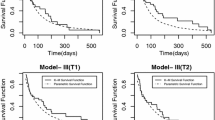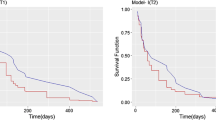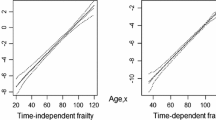Summary
Frailty models are widely employed in bivariate survival data as they allow us to model the dependence through common random effect. The frailty models developed in literature are based on the assumption that the frailty random variables act multiplicatively on the baseline hazard rates and those models are useful for the analysis of right censored data. In the present paper, we introduce a class of semiparametric frailty models in terms of reversed hazard rates, which is useful for the analysis of left censored data. The shared gamma frailty reversed hazards model and correlated gamma frailty reversed hazards model are studied. The estimation of the parameters of the models by maximum likelihood method, using EM algorithm, is presented. The properties of the estimates are also discussed. The gamma frailty reversed hazards models in presence of observed covariates are also studied. Finally, we apply the models to a real data set.
Similar content being viewed by others
References
Andersen, P. K., Borgan, Ø., Gill, R. D. and Keilding, N.(1993) Statistical Models Based on Counting Processes, Berlin, Springer-Verlag, New York.
Balakrishnan, N. and Peng, Y. (2006) Generalized gamma frailty model, Statistics in Medicine, 25, 2797–2816.
Barlow, R. E., Marshall, A. W. and Proshan, F. (1963) Properties of probability distributions with monotone hazard rate, The Annals of Mathematical Statistics, 34, 375–389.
Block, H. W., Savits, T. H. and Singh, H. (1998) The reversed hazard rate function, Probability in Engineering and Informational Sciences, 12, 69–90.
Chen, Y. Q., Wang, M. C. and Huang, Y. (2004) Semiparametric regression analysis on longitudinal pattern of recurrent gap times, Biostatistics, 5, 277–290.
Clayton, D. and Cuzick, J. (1985) Multivariate generalizations of the proportional hazards model, Journal of the Royal Statistical Society Series. A, 148, 82–117.
Clayton, D. G. (1978) Amodelforassociationinbivariate life tables and its applications in epidemiological studies of familial tendency in chronic disease incidence, Biometrika, 65, 141–151.
Crouchley, R. and Pickles, A. R. (1995) Multivariate survival models for repeated and correlated events, Journal of Statistical Planning and Inference, 47, 95–110.
DI Crescenzo, A. (2000) Some results on the proportional reversed hazards model, Statistics and Probability Letters, 50, 313–321.
Duffy, D. L., Martin, N. G. and Mathews, J. D. (1990) Appendectomy in Australian twins, American Journal of Human Genetics, 47, 590–592.
Efron, B. and Tibshirani, R. J. (1993) An introduction to the bootstrap, Chapman and Hall, New York.
Gupta, R. C. and Gupta, R. D. (2007) Proportional reversed hazard rate model and its applications, Journal of Statistical Planning and Inference, 137, 3525–3536.
Gupta, R. C., Gupta, R. D. and Gupta, P. L. (1998) Modelling failure time data by Lehman alternatives, Communication in Statistics-Theory and Methods, 27, 887–904.
Gurler, Ü. (1996) Bivariate estimation with right truncated data, Journal of the American Statistical Association, 91, 1152–1165.
Honore, B. E. (1993) Identification results for duration models with multiple spells, Review of Economic Studies, 60, 241–246.
Hougaard, P. (2000) Analysis of Multivariate Survival Data, Springer-Verlag, New York.
Iachine I. A. (2001) The use of Twin and Family Survival Data in the Population Studies of Aging: Statistical Methods Based on Multivariate Survival Models, Ph.D Thesis, University of Southern Denmark.
Iachine I. A. (2004) Identifiability of bivariate frailty models, Preprint 5, Department of Statistics, University of Southern Denmark, Odense.
Klein, J. P. (1992) Semi parametric estimation of random effects using Cox model based on EM algorithm, Biometrics, 48, 795–806.
Lawless, J. F. (2003) Statistical Models and Methods for Lifetime Data, Wiley, New York.
Maller, R. A. and Zhou X. (2003) Testing for individual heterogeneity in parametric models for event history data, Math Methods Stat, 12, 276–304.
Murphy, S. A. (1994) Consistency in a proportional hazards model incorporating a random effect, The Annals of Statistics, 22, 712–731.
Murphy, S. A. (1995) Asymptotic theory for the frailty model, The Annals of Statistics, 23, 182–198.
Nielsen, G. G., Gill, R. D., Andersen, P. K. and Sørensen, T. I. A. (1992) A counting process approach to maximum likelihood estimation in frailty models, Scandinavian Journal of Statistics, 19, 25–43.
Oakes, D. (1982) A model for association in bivariate survival data, Journal of the Royal Statistical Society, Series B, 44, 414–422.
Oldmeadow, C., Mengersen K., Martin N. and Duffy D. L. (2009) Heritability and linkage analysis of appendicitis utilizing age at onset, Twin Research and Human Genetics, 12, 150–157.
Parner, E. (1998) Asymptotic theory for the correlated gamma frailty model, The Annals of Statistics, 26, 183–214.
Sankaran, P. G. and Gleeja, V. L. (2006) On bivariate reversed hazard rates, Journal of the Japan Statistical Society, 36, 213–224.
Sankaran, P. G. and Gleeja, V. L. (2008) Proportionalreversedhazardandfrailtymodels, Metrika, 68, 333–342.
Sengupta, D., Singh, H. and Nanda, A. K. (1998) The proportional reversed hazard model, Technical report, Applied Statistics Division, Calcutta: Indian Statistical Institute.
Vaupel, J. W., Manton, K. G. and Stallard, E. (1979) The impact of heterogeneity in individual frailty on the dynamics of mortality, Demography, 16, 439–454.
Wienke, A. (2010) Frailty Models in Survival Analysis, Chapman & Hall/CRC, Boca Raton.
Wienke, A., Arbeev, K. G., Locatelli, I. and Yashin, A. I. (2005) A comparison of different bivariate correlated frailty models and estimation strategies, Mathematical Biosciences, 198, 1–13.
Yashin, A. I. and Iachine, I. A. (1995a) Genetic analysis of durations: Correlated frailty model applied to survival of Danish Twins, Genetic Epidemiology, 12, 529–538.
Yashin, A. I. and Iachine, I. A. (1995b) How long can human live? Lower bound for biological limit of human longevity calculated from Danish twin data using correlated frailty model, Mechanism of Ageing and Development, 80, 147–169.
Yashin, A. I. and Iachine, I. A. (1997) How frailty models can be used for evaluating longevity limits: Taking advantage of an interdisciplinary approach, Demography, 34, 31–48.
Yashin, A. I. and Iachine, I. A. (1999a) Dependent hazards in multivariate survival problems, Journal of Multivariate Analysis, 71, 241–261.
Yashin, A. I. and Iachine, I. A. (1999b) What difference does the dependence between durations make? Insights for population studies of aging, Lifetime Data Analysis, 5, 5–22.
Author information
Authors and Affiliations
Corresponding author
Rights and permissions
About this article
Cite this article
Sankaran, P.G., Gleeja, V.L. On proportional reversed hazards frailty models. METRON 69, 151–173 (2011). https://doi.org/10.1007/BF03263554
Received:
Revised:
Published:
Issue Date:
DOI: https://doi.org/10.1007/BF03263554




